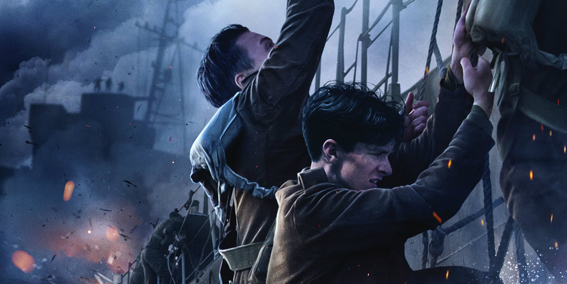
A tense, barrage of the senses that has brief moments of respite, Christopher Nolan‘s latest film centres on the evacuation of British forces from the coast of France, while slowly being flanked by German forces. It’s a situation fraught with hopelessness and desperation, and is chronicled beautifully in this retelling of those fateful few days.
Rather than conveying the events in a typical war movie fashion, Dunkirk unfolds onscreen in three different timelines, and from three different points of view. With each perspective taking place at a different period of time, a week, a day and an hour from the evacuation, the timelines all interweave as the events catch up with one another. In lesser hands this would be a very confusing way of presenting a story but under the masterful guidance of Nolan, this unique approach adds another dimension to Dunkirk. One that makes the audiences privy to things happening before the characters in the film, and which increases the tension as we know what is about to take place.

With its focus on scared and exhausted men just trying to survive, the film eschews from the typical battle scenes of soldiers mowing each other down, an unending onslaught of gunfire and explosions. We never see the faces of the enemy, just the results of their actions, the camera rather concentrating on the battered soldiers of the British forces, or on the sailors and fishermen sailing from England in their small boats, trying to get to Dunkirk to save their fellow men.
We do not get to know much about the characters in the way of names or much of their past but we don’t need to. Everything we need to know takes place right before us. A soldier (Fionn Whitehead) just wanting to get home, a pilot (Tom Hardy) doing everything he can to give his compatriots a fighting chance, a father (Mark Rylance) determined to save as many of the beleaguered troops as he can, the essence of these self-contained stories gives the audience something to invest in, often times leaving them at the edge of their seat as they wait for the next moment to unfold. It’s an impressive feat of story-telling especially when you consider that some characters barely speak, and others, spend the majority of the film with their faces hidden behind a flight mask.

And as Nolan is ratcheting up the intensity visually onscreen, Hans Zimmer’s score is constantly looming over everything, oppressive, filling the theatre with low rumbling bass one minute, then adding to the tension even further with its staccato ticking and drawn out strings. The music, much like the action did not let up, pushing into you, pulsating, almost bringing your heart to your throat. But the real standout of the movie is the sound design; the creaking of the boats, the crashing of the waves, the high-pitched whirring of approaching planes, an ominous portent of death and destruction. All these incredible parts connecting together to produce one incredible whole.
Dunkirk is not an easy film to watch. It’s intense and emotionally draining. But it is a film I would recommend that you go see. It’s something to be experienced, and if you get a chance, see it in IMAX.
I give Dunkirk a 9 out of 10.




spot on review….good job…..www.fredsportsextra.com
LikeLiked by 1 person